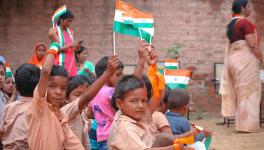Three Years of BJP Government: Double Whammy for the Indian People

Image Courtesy: Cobrapost Hindi
THE BJP government is celebrating the completion of three years in office with their trademark grandiose and fanfare. Seen from the perspective of the vast majority of the Indian people, there is no occasion for any celebration. The livelihood conditions of the Indian people have sharply deteriorated during the course of these three years.
The BJP government, under Prime Minister Narendra Modi, has unveiled the true character of the BJP functioning as the political arm of the RSS. The RSS continues to pursue its ideological project of converting the secular democratic Republic into their version of a rabidly intolerant fascistic `Hindu Rashtra’.
In the process, the government has unleashed a quadruple attack on India and the people. At one level, there is a sharp rise of communal polarisation with growing murderous attacks on dalits and the Muslim minority community; secondly, neo-liberal economic reforms are being pursued more aggressively by this government than ever before; thirdly, growing authoritarian trends are undermining the democratic and parliamentary institutions; and lastly, India has been reduced to the status of a junior strategic partner of US imperialism.
DETERIORATING PEOPLE’S LIVELIHOOD CONDITIONS
This BJP government assumed office promising acche din for the people. It had promised to create two crores of jobs every year. As against this, the job creation in eight major industrial sectors in the country was lowest in the last eight years. 1.35 lakh jobs were created in these sectors in 2015. In 2016, the Labour Bureau reports that 2.31 lakh jobs were created. Over and above the backlog of huge unemployment in the country, 1.5 crore youth join the job market every year. Even amongst those who are working, the ILO reports that 35 per cent of India’s working people are `under employed’.
The much tom-tomed IT sector has reported a dismal picture regarding job creation. International agency, McKinsey has estimated that amongst the 40 lakh workers in the IT sector today, nearly 50 to 60 per cent would be rendered redundant. Three major IT companies – Infosys, Wipro and Cognizant – have reported considering retrenching 56,000 workers. The IITs, across the country, have reported a sharp fall in corporates hiring students passing out from the campuses.
Rural employment has been severely curtailed with the refusal of this BJP government to release funds for the legal commitments made under the MGNREGA. The government, on an average, has reportedly informed that during the course of these three years, more than 20,000 people under this scheme were denied payment of wages each year. Take the case of Tripura, a state which ranks number one in providing the maximum mandays under this scheme, averaging around 94, the funds released by the central government are so meagre that Tripura can now only offer 42 mandays, ie, less than half of what was there during the past three years.
The scenario for the future looks bleak on both the employment as well as industrial/manufacturing front. The growth rate of industrial output has dropped from 5.5 per cent to 2.7 per cent last year. Credit growth from the banking sector has dipped to its lowest level in 63 years. Clearly, manufacturing activity has declined considerably reflected in this fall of banking credit growth.
The demonetisation had crippled the informal sector of our economy which contributes to over 40 per cent of our GDP and accounts for nearly three-fourths of our employment.
The conditions in rural India have worsened during these last three years. The central government has informed the apex court that, on an average, 12,000 farmers have been committing distress suicides in every one of these three years. The major reason for these distress suicides is the debt burden under which the majority of the Indian farmers are groaning. Three years ago, this BJP government promised to increase the minimum support price for our farmers to the level of one and a half times the input costs required for agricultural operations. The government has betrayed the peasantry on this account as well.
On top of this, the import duty on wheat has been eliminated resulting in wheat coming into the market at a price lower than the MSP declared by the government. The farmers are being forced to undertake distress sales which further worsen the debt burden. Even the existing MSP is not being paid to the farmers for many crops, including cotton. This is the state of our annadatas during the course of these three years.
While this government is considering proposals for restructuring (read `writing off’) the massive loans taken by Indian corporates from our nationalised banks, it is not prepared to consider the restructuring of loans taken by our farmers. The outstanding NPAs against corporates, including interest, would amount to a humongous Rs 11 lakh crores. While the poor farmers are harassed with the properties and cattle being attached by the bank, pushing them towards distress suicides, no punitive action against any defaulting corporates is even being considered. This is the true character of this government that has been exposed during the course of these three years.
GROWING INEQUALITIES
Naturally, under these conditions, the Human Development Indicators for the vast majority of the Indian people has sharply declined. The reputed international medical journal, The Lancet, has shown that India ranks at a low position of 154 out of 195 countries on the global index of `burden of disease’. India has fallen eleven places on this index during the last one year. Indian people today face a `burden of disease’ which is worse than our sub-continent neighbours like Sri Lanka, Nepal, Bhutan and Bangladesh.
Such anti-people policies of enriching the rich and impoverishing the poor have resulted in a huge growth of economic inequalities. Between 2014 and 2016, the richest one per cent of Indians increased their share of nation’s wealth from 49 per cent to 58.4 per cent. This figure stood at 36.8 per cent in 2000. The same Credit Suisse report that gives this information also shows a more alarming feature that the share of the bottom 70 per cent of Indians together is today just 7 per cent of the nation’s wealth. This figure was double at 14 per cent that this 70 per cent owned in 2010.
The latest National Sample Survey report on household expenditure in India shows the huge gulf between the rich and poor that is widening in a rapid manner. The top 10 per cent of Indian households today have an average asset holding of Rs 1.5 crore. This is 50,034 times the average value of assets held by an urban household of the bottom 10 per cent of our country.
The expenditures of India’s poor are so meagre that this does not figure in any compilation of statistics of macro entities of GDP or tax collections. In fact the lower half of India’s population spends virtually nothing on any item other than what is required for their survival. Given these disparities the devastation that the demonetisation has struck on India’s poor had made little difference to the overall spending patterns in the country because it is only the rich and to a certain extent the upper section of the middle class that spends. This explains why the figures for the GDP or that for the tax collections or for that matter the sensex do not show a decline following demonetisation. In other words, it is not that demonetisation was not inconsequential to people’s livelihood, it devastated India’s other half while statistically this does not get reflected.
SHARPENING COMMUNAL POLARISATION
In almost all BJP ruled states, private armies in the name of cow protection have surfaced that are mounting murderous attacks on dalits and minorities. Squads for `moral policing’ like the anti-Romeo squad in Uttar Pradesh or Sri Ram Sena in Karnataka continuously harass our youth prescribing what to wear, what to eat, whom to befriend etc. Unless such private armies are banned, the protection of the rights of the dalits and minorities cannot be ensured.
The situation in the state of Jammu & Kashmir continues to worsen. This BJP government’s Kashmir policy has proved to be a complete failure. The government has reneged on its promises of implementing some confidence building measures in Jammu & Kashmir and starting the political process of a dialogue with all stakeholders in the state.
There is a systematic and intensive effort to change the country’s education policy. Syllabus to be taught in schools and colleges is being rapidly communalised. To control the institutions of research and higher education, central universities like JNU and HCU are under attack to destroy the progressive and secular content of these institutions.
All these put together amount to the advancing of the RSS agenda to convert the secular democratic Republic into their version of a rabidly intolerant fascistic `Hindu Rashtra’.
UNDERMINING INSTITUTIONS
Parliamentary institutions are being undermined. This government is taking frequent recourse of declaring various legislations as `money bills’ in order to avoid the Rajya Sabha where it does not have a majority. Most of the legislative business is passed without discussions in the Lok Sabha where the BJP exercises its tyranny of majority.
Recently, the laws governing the donations made to political parties by the corporates have been amended in such a manner that they will now legalise political corruption. The existing limits on the amounts the corporates can donate to political parties have been removed. The transparency of such donations are also being adversely affected with the introduction of electoral bonds. It is no longer necessary to know who has bought the electoral bonds and given it to which political parties. Thus, there is no transparency any longer for political funding and, therefore, no accountability. This government refuses to amend the existing laws to impose a ceiling on the expenditures of political parties during elections, nor, ban corporate funding of political parties. Consequently, the role of money power distorting the democratic choices of the people has sharply increased.
India has now opened up almost all areas of its economy for the in-flow of foreign funds. This includes crucial sensitive sectors like defence production. This largely facilitates the profit maximisation of multinational corporations at the expense of the Indian economy and the people. A massive drive of privatisation of the public sector has been launched.
With the signing of Indo-US treaties, India has entered into a logistics sharing arrangement with the USA and has been accorded the status of a `US defence partner’. This is not in the interests of India’s independent foreign policy status and position in the world.
These three years, hence, have seen an all-round attack on the vast majority of the Indian people. The people’s discontent is being sought to be diverted away from protests against the BJP government and its policies through the rousing of jingoistic nationalism of the Hindutva variety. All patriotic Indian people have to uphold the banner of Indian patriotism as opposed to the whipping up of Hindutva nationalism. These three years have shown that it is only the power of popular united struggles that can put the pressure on this government to change its policy direction in favour of improving people’s livelihood and to safeguard the republican character of our country.
Disclaimer: The views expressed here are the author's personal views, and do not necessarily represent the views of Newsclick.
Get the latest reports & analysis with people's perspective on Protests, movements & deep analytical videos, discussions of the current affairs in your Telegram app. Subscribe to NewsClick's Telegram channel & get Real-Time updates on stories, as they get published on our website.
























